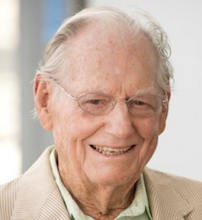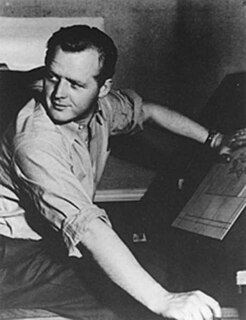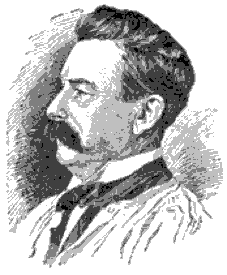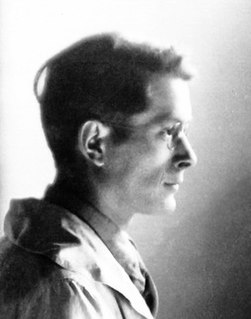
Morton Wayne Thiebaud was an American painter known for his colorful works depicting commonplace objects—pies, lipsticks, paint cans, ice cream cones, pastries, and hot dogs—as well as for his landscapes and figure paintings. Thiebaud is associated with the pop art movement because of his interest in objects of mass culture, although his early works, executed during the fifties and sixties, slightly predate the works of the classic pop artists. Thiebaud used heavy pigment and exaggerated colors to depict his subjects, and the well-defined shadows characteristic of advertisements are almost always included in his work.
Julian Stanczak was a Polish-born American painter and printmaker. The artist lived and worked in Seven Hills, Ohio with his wife, the sculptor Barbara Stanczak.

John Anthony Baldessari was an American conceptual artist known for his work featuring found photography and appropriated images. He lived and worked in Santa Monica and Venice, California.

Henry Mosler was a German-born painter who documented American life, including colonial themes, Civil War illustrations, and portraits of men and women of society.

Millard Owen Sheets was an American artist, teacher, and architectural designer. He was one of the earliest of the California Scene Painting artists and helped define the art movement. Many of his large-scale building-mounted mosaics from the mid-20th century are still extant in Southern California. His paintings are in the Metropolitan Museum of Art and the Whitney Museum in New York, the Chicago Art Institute, the National Gallery in Washington D.C.; and the Los Angeles County Museum.

Robert Seldon Duncanson was a 19th-century American landscapist of European and African ancestry. Inspired by famous American landscape artists like Thomas Cole, Duncanson created renowned landscape paintings and is considered a second generation Hudson River School artist. Duncanson spent the majority of his career in Cincinnati, Ohio and helped develop the Ohio River Valley landscape tradition. As a free black man in antebellum America, Duncanson engaged the abolitionist community in America and England to support and promote his work. Duncanson is considered the first African-American artist to be internationally known. He operated in the cultural circles of Cincinnati, Detroit, Montreal, and London. The primary art historical debate centered on Duncanson concerns the role that contemporary racial issues played in his work. Some art historians, like Joseph D. Ketner, believe that Duncanson used racial metaphors in his artwork, while others, like Margaret Rose Vendryes, discourage viewers from approaching his art with a racialized perspective.

Lucile Lloyd, also known as Lucile Lloyd Brown, Lucila Lloyd Nulty was an American muralist, illustrator, and decorative painter. In 1937, Lloyd worked with the Works Progress Administration's Federal Arts Project to paint three murals in the assembly room in the state building in Los Angeles, California.

Reuben Tam was an American landscape painter, educator, poet and graphic artist.
Fletcher C. Benton was an American sculptor and painter from San Francisco, California. Benton was widely known for his kinetic art as well as his large-scale steel abstract geometric sculptures.
Ed Moses was an American artist based in Los Angeles and a central figure of postwar West Coast art.

Fourteen Rembrandt paintings are held in collections in Southern California. This accumulation began with J. Paul Getty's purchase of the Portrait of Marten Looten in 1938, and is now the third-largest concentration of Rembrandt paintings in the United States. Portrait of Marten Looten is now housed at the Los Angeles County Museum of Art (LACMA).
California Tonalism was art movement that existed in California from circa 1890 to 1920. Tonalist are usually intimate works, painted with a limited palette. Tonalist paintings are softly expressive, suggestive rather than detailed, often depicting the landscape at twilight or evening, when there is an absence of contrast. Tonalist paintings could also be figurative, but in them, the figure was usually out of doors or in an interior in a low-key setting with little detail.

Eli Harvey was an American sculptor, painter and animalier.
John Millard Ferren was an American artist and educator. He was active from 1920 until 1970 in San Francisco, Paris and New York City.
Kathryn Woodman Leighton was an American artist, based in Los Angeles, California, best known for her Western landscapes and for portraits of Native Americans.
Nell Brooker Mayhew was an American painter, etcher and art instructor.

Cornelis Botke (1887-1954) was a Dutch-born American painter and etcher. He emigrated to the United States in 1930, and he first lived in Chicago before moving to Southern California. By the time of his death, his artwork hung in the New York Public Library, the Los Angeles Public Library, and the California State Library. His wife, Jessie Arms Botke, was also an artist.
Carlos J. Anderson was an American painter, illustrator and graphic designer. He did American Scene paintings of Utah pioneer buildings and scenery.
Arthur Millier was a British-born American painter, etcher, printmaker, and art critic. He was the art critic for the Los Angeles Times from 1926 to 1958. His work is in the permanent collections of many museums in the United States.
Clarence Keiser Hinkle was an American painter and art educator. His art studio was in Laguna Beach, California and later in Santa Barbara, California.









